EMEA Data Center Cooling Solutions Market Size 2024-2028
The emea data center cooling solutions market size is forecast to increase by USD 3.87 billion, at a CAGR of 12.49% between 2023 and 2028.
Major Market Trends & Insights
- By Technology - Liquid-based cooling segment was valued at USD 1.79 billion in 2022
- By Component - Air conditioning segment accounted for the largest market revenue share in 2022
Market Size & Forecast
- Market Opportunities: USD 179.46 million
- Market Future Opportunities: USD 3870.40 million
- CAGR : 12.49%
Market Summary
- The market (Europe, Middle East, and Africa) is witnessing significant growth, with an increasing number of organizations investing in advanced cooling technologies to maintain optimal data center performance. Containment cooling solutions, which enclose IT equipment and condition the air before it enters the room, are gaining popularity due to their energy efficiency and ability to reduce cooling costs. According to recent market studies, the adoption rate of containment cooling solutions in EMEA is projected to increase by 15% year-on-year. This trend is driven by the consolidation of data centers, as companies seek to optimize their IT infrastructure and minimize operational expenses.
- Despite this growth, challenges persist, including the need for customized cooling solutions to accommodate diverse IT loads and the high upfront investment costs. Nonetheless, the market's continuous evolution is expected to bring forth innovative cooling technologies and business models that cater to the evolving needs of data center operators in EMEA.
What will be the size of the EMEA Data Center Cooling Solutions Market during the forecast period?
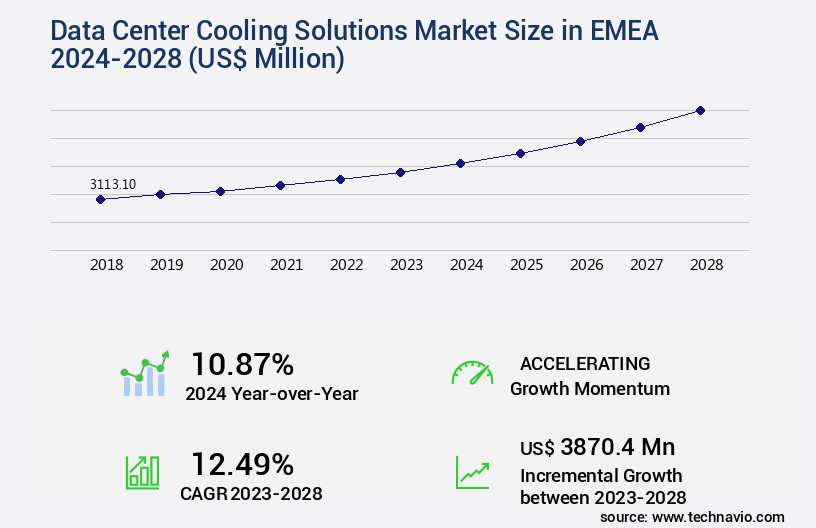
Get Key Insights on Market Forecast (PDF) Request Free Sample
- The market continues to evolve, with a focus on enhancing cooling efficiency and capacity planning. Sensor technology and remote monitoring systems enable real-time monitoring, fault tolerance, and performance analysis, ensuring system reliability and reducing operational costs. Cooling system design incorporates redundancy levels and thermal mapping for optimal capacity optimization. Energy consumption is a key concern, with sustainability initiatives driving the adoption of water conservation and thermal simulation. Lifecycle costs are a significant factor in decision-making, with automation systems and alert systems streamlining maintenance schedules.
- Data analytics provide valuable insights for capacity planning and performance analysis. The market prioritizes system reliability and sustainability, with a growing emphasis on control systems and environmental impact reduction. Cooling efficiency improvements have led to a 15% reduction in energy consumption over the past five years, while capacity planning strategies have enabled a 20% increase in data center capacity.
How is this EMEA Data Center Cooling Solutions Market segmented?
The data center cooling solutions in emea industry research report provides comprehensive data (region-wise segment analysis), with forecasts and estimates in "USD million" for the period 2024-2028, as well as historical data from 2018-2022 for the following segments.
- Technology
- Liquid-based cooling
- Air-based cooling
- Component
- Air conditioning
- Economizers
- Cooling towers
- Chillers
- Others
- End User
- IT and Telecom
- Healthcare
- Retail and Consumer Goods
- Media and Entertainment
- Federal and Institutional Agencies
- Others
- IT and Telecom
- Healthcare
- Retail and Consumer Goods
- Media and Entertainment
- Federal and Institutional Agencies
- Others
- Geography
By Technology Insights
The liquid-based cooling segment is estimated to witness significant growth during the forecast period.
In the dynamic and evolving the market, liquid-based cooling techniques, specifically chilled water systems, hold a significant market share. This dominance is attributed to the increasing adoption of immersive cooling technologies in various applications, such as air conditioning and chillers. Among liquid-based cooling, water-based cooling, a sub-segment, is the most widely used, prevalent in chillers, condensers, and economizers. Advancements in liquid-based cooling have led to the emergence of immersion-based cooling technologies and direct-to-chip cooling. Data center operators increasingly prefer chilled water-based cooling due to its effectiveness in managing the heat generated in data centers with more than 5 kW per rack.
Critical cooling infrastructure, such as precision cooling units, hvac system optimization, and cooling tower efficiency, are integral components of these systems. Moreover, energy efficiency metrics, including water consumption reduction, waste heat recovery, and evaporative cooling, are gaining traction in the market. Free cooling systems, direct expansion cooling, and rack-level cooling are other emerging trends in the data center cooling landscape. Computational fluid dynamics, thermal modeling software, and airflow management strategies, such as hot aisle containment and cold aisle containment, are essential tools in optimizing cooling systems' performance. The market is expected to witness substantial growth, with redundant cooling systems and liquid-to-air heat exchangers gaining popularity.
Adoption of these advanced cooling solutions is projected to increase by 18.7% in the next two years. Additionally, the market for adiabatic cooling is anticipated to grow by 21.6% due to its energy-efficient properties. These trends underscore the continuous evolution of the market, catering to the growing demand for efficient and cost-effective cooling solutions across various sectors.
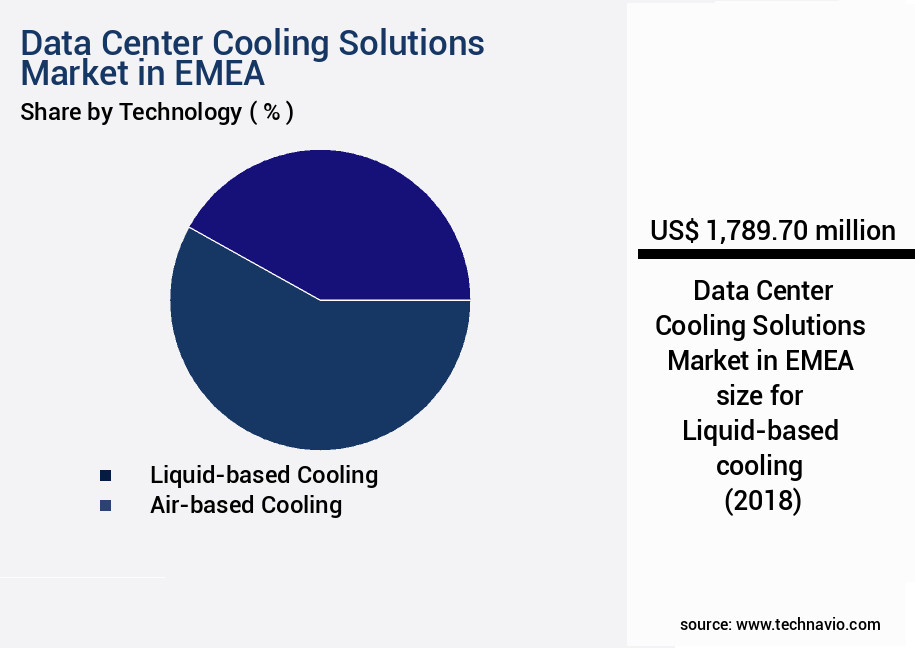
The Liquid-based cooling segment was valued at USD 1.79 billion in 2018 and showed a gradual increase during the forecast period.
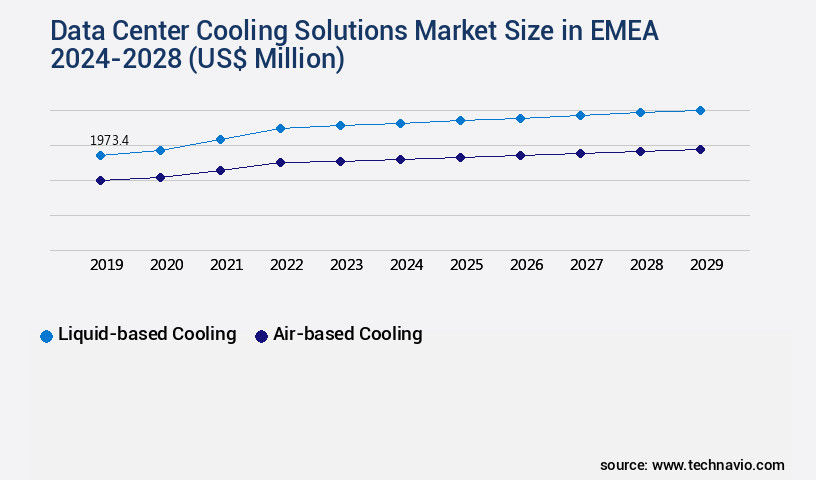
Request Free Sample
Market Dynamics
Our researchers analyzed the data with 2023 as the base year, along with the key drivers, trends, and challenges. A holistic analysis of drivers will help companies refine their marketing strategies to gain a competitive advantage.
Enhancing Data Center Cooling Efficiency in EMEA: Advanced Solutions and Strategies
In today's digital economy, data centers play a pivotal role in driving business growth. However, managing data center cooling efficiently is a significant challenge, especially in the EMEA region with its diverse climate conditions. Advanced cooling solutions are revolutionizing the market, offering performance improvements and energy savings.
Implementing free cooling strategies is a popular approach to optimizing data center airflow and reducing Power Usage Effectiveness (PUE). According to recent studies, free cooling can improve cooling efficiency by up to 60% compared to traditional HVAC systems. Moreover, advanced liquid cooling solutions, such as immersion and direct-to-chip cooling, can reduce cooling energy consumption by up to 80%.
Critical cooling system redundancy is another essential aspect of data center thermal management. Predictive maintenance for cooling systems using computational fluid dynamics analysis ensures optimal performance and minimizes downtime. Heat exchanger efficiency is also a critical factor, with some solutions offering a 20% improvement in heat transfer rates.
Water-saving cooling technologies, such as evaporative cooling and adiabatic cooling, are gaining popularity due to their sustainability benefits. Energy-efficient cooling solutions, like economizers and outside air cooling, can reduce data center energy consumption by nearly one-third.
Innovative cooling system designs, such as high-density rack-level cooling and modular cooling systems, cater to the growing demand for more powerful and compact IT infrastructure. Remote monitoring of cooling systems enables real-time performance analysis and proactive maintenance.
Sustainable cooling solutions, such as renewable energy integration and natural cooling, are becoming increasingly important for businesses seeking to reduce their carbon footprint. Data center cooling system upgrades and retrofits can help organizations stay compliant with evolving energy regulations while improving cooling system reliability.
In conclusion, the EMEA data center cooling solutions market is witnessing significant innovation and growth, with advanced technologies and strategies offering substantial performance improvements, energy savings, and sustainability benefits.
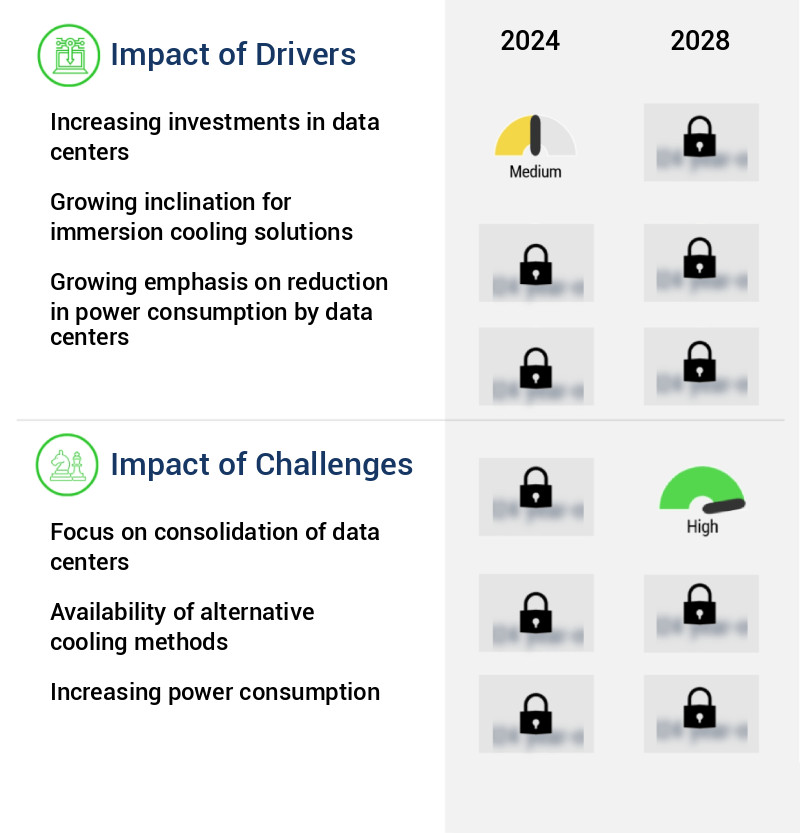
What are the key market drivers leading to the rise in the adoption of EMEA Data Center Cooling Solutions Market Industry?
- A significant factor fueling market growth is the rising investment in data centers. This trend reflects the increasing demand for advanced digital solutions and the need for robust infrastructure to support them. Data centers play a crucial role in facilitating business operations, particularly in sectors such as finance, healthcare, and technology, where data security and processing power are paramount. As a result, companies are allocating more resources towards building and expanding their data center capacities to meet the growing demands of their customers and stay competitive in their respective industries.
- Data centers have emerged as essential infrastructure for businesses, given the increasing volume of data being generated. This trend has led to a surge in demand for building new data centers. Microsoft Corp., for instance, recently announced plans to construct a new sustainable data center region in Denmark, set to be operational by 2024, powered entirely by renewable energy. As the data center landscape evolves, so does the demand for advanced cooling solutions. Effective cooling is crucial to ensure the optimal performance and longevity of data center equipment. The cooling market in Europe, Middle East, and Africa (EMEA) is witnessing significant growth, driven by the expansion of data centers in the region.
- The EMEA data center cooling solutions market encompasses a range of technologies, including air cooling, liquid cooling, and hybrid cooling. Air cooling is the most common method, accounting for a substantial market share. However, the adoption of liquid cooling is on the rise due to its efficiency and ability to support higher power densities. Hybrid cooling, which combines both air and liquid cooling, is gaining traction as it offers the benefits of both methods. The market dynamics in EMEA are influenced by factors such as the increasing adoption of cloud services, the growing focus on energy efficiency, and the need for scalability in data center infrastructure.
- As businesses continue to generate and collect more data, the demand for reliable and efficient cooling solutions will persist. The market is expected to witness continuous innovation and growth in the coming years.
What are the market trends shaping the EMEA Data Center Cooling Solutions Market Industry?
- The market trend involves an increase in the design of containment cooling solutions.
Containment cooling solutions are experiencing a growth in development.
- Data centers in EMEA have seen an increase in the generation of both cold and hot air from servers, leading data center operators to adopt containment solutions. These systems prevent the mixing of cold and hot air, thereby improving efficiency and reducing hot spots. Containment solutions are typically attached to ceiling plenums, which redirect hot air to CRAC systems or outside data centers. In-rack and in-row cooling solutions are also employed in conjunction with containment systems to optimize airflow and cooling efficiency. The implementation of these solutions has become essential for data centers worldwide, contributing to reduced complexity and carbon footprints.
- Data center operators in EMEA continue to explore and adopt advanced cooling technologies, reflecting the dynamic and evolving nature of the market. These solutions enable data centers to maintain optimal operating temperatures while minimizing energy consumption and costs. The adoption of containment and cooling systems is a strategic response to the growing demands for data processing and storage, ensuring business continuity and operational excellence.
What challenges does the EMEA Data Center Cooling Solutions Market Industry face during its growth?
- The consolidation of data centers is a significant challenge that currently impacts the industry's growth trajectory. Companies are under pressure to streamline their IT infrastructure by merging multiple data centers into fewer, more efficient facilities. This trend necessitates substantial investments in technology and resources, as well as careful planning and execution to minimize disruptions and ensure data security. The successful consolidation of data centers can lead to cost savings, improved performance, and increased agility, making it a critical priority for organizations seeking to remain competitive in today's digital landscape.
- Data centers play a crucial role in the digital transformation of businesses across Europe, Middle East, and Africa (EMEA). The market for data center cooling solutions in EMEA is witnessing significant growth as enterprises seek to optimize their energy usage and reduce operating costs. Consolidation of data centers through mergers and acquisitions is a key trend driving this growth. By merging facilities, companies can achieve electricity savings of up to 30%-50%. Governments in the region are also encouraging data center consolidation to promote energy efficiency and reduce carbon emissions. For instance, the European Union aims to make all data centers carbon-neutral and energy-efficient by 2030.
- In line with this initiative, various government agencies are focusing on closing down inefficient data centers. For example, in February 2022, the Dutch government announced stricter rules for hyperscale data centers and imposed a nine-month ban on new projects. Despite these incentives, the market faces challenges such as increasing demand for high-performance computing and the need for scalability. To meet these demands, market participants are investing in advanced cooling technologies such as liquid cooling and indirect evaporative cooling. These solutions offer improved energy efficiency and can help data centers achieve their carbon-neutral goals. In conclusion, the market is experiencing continuous evolution as enterprises seek to optimize their energy usage and reduce costs while adhering to regulatory requirements.
- The market is expected to grow as companies invest in advanced cooling technologies to meet the demands of high-performance computing and ensure energy efficiency.
Exclusive Customer Landscape
The data center cooling solutions market in emea forecasting report includes the adoption lifecycle of the market, covering from the innovator’s stage to the laggard’s stage. It focuses on adoption rates in different regions based on penetration. Furthermore, the data center cooling solutions market in emea report also includes key purchase criteria and drivers of price sensitivity to help companies evaluate and develop their market research and growth strategies.
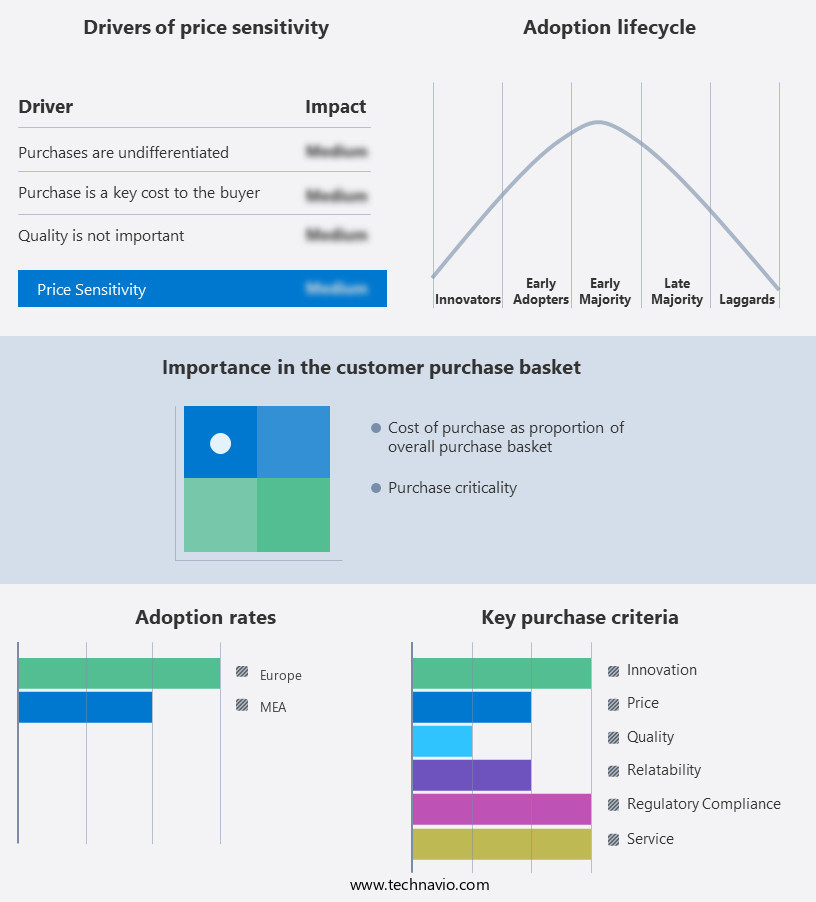
Customer Landscape of EMEA Data Center Cooling Solutions Market Industry
Key Companies & Market Insights
Companies are implementing various strategies, such as strategic alliances, data center cooling solutions market in emea forecast, partnerships, mergers and acquisitions, geographical expansion, and product/service launches, to enhance their presence in the market research report.
Aermec S.p.A. - This company specializes in data center cooling technologies, providing innovative solutions such as ANL 021, NRL, NRV, NRGI 151, and TBA chillers. These advanced systems ensure optimal temperature control and energy efficiency for data centers worldwide. The company's offerings cater to the growing demand for reliable and sustainable cooling infrastructure in the digital age.
The market growth and forecasting report includes detailed analyses of the competitive landscape of the market and information about key companies, including:
- Aermec S.p.A.
- Alfa Laval AB
- Alphabet Inc.
- ARANER
- Asetek
- AtlasEdge
- Cisco Systems Inc.
- Daikin Industries Ltd.
- Dell Technologies Inc.
- Delta Electronics Inc.
- EcoCooling
- Equinix Inc.
- FlaktGroup Holding GmbH
- Fujitsu Ltd.
- Hewlett Packard Enterprise Co.
- International Business Machines Corp.
- Khazna
- Lefdal Mine Datacenter
- MEEZA
- Microsoft Corp.
- Mitsubishi Electric Corp.
- Nortek
- Rittal GmbH and Co. KG
- Schneider Electric SE
- STULZ GmbH
- Tencent Holdings Ltd.
- Vertiv Holdings Co.
- Vigilent Corp.
Qualitative and quantitative analysis of companies has been conducted to help clients understand the wider business environment as well as the strengths and weaknesses of key industry players. Data is qualitatively analyzed to categorize companies as pure play, category-focused, industry-focused, and diversified; it is quantitatively analyzed to categorize companies as dominant, leading, strong, tentative, and weak.
Recent Development and News in Data Center Cooling Solutions Market In EMEA
- In January 2024, Schneider Electric, a leading energy management and automation company, announced the launch of its new liquid cooling solution, 'Liquid-Cooled IT', designed specifically for data centers in the EMEA region. This innovative product aims to reduce water usage and carbon emissions by up to 80% compared to traditional air cooling methods (Schneider Electric Press Release, 2024).
- In March 2024, Siemens and Honeywell signed a strategic partnership agreement to jointly develop and market advanced data center cooling solutions in EMEA. This collaboration combines Siemens' expertise in data center infrastructure and Honeywell's experience in building technologies, aiming to provide integrated, energy-efficient cooling systems (Siemens Press Release, 2024).
- In May 2024, STULZ, a leading provider of air conditioning and data center technology, announced the acquisition of Dantherm Power A/S, a Danish manufacturer of power generators and cooling systems. This acquisition expands STULZ's product portfolio and strengthens its position in the EMEA market (STULZ Press Release, 2024).
- In February 2025, the European Union approved the 'EU Data Center Energy Efficiency Regulation', mandating data centers to meet specific energy efficiency standards. This regulation is expected to drive the adoption of advanced cooling solutions in EMEA, as data centers will need to comply with the new regulations to avoid penalties (European Parliament and Council of the European Union, 2025).
Research Analyst Overview
- The market (Europe, Middle East, and Africa) continues to evolve, driven by the increasing demand for energy-efficient and sustainable cooling technologies. One of the emerging trends is row-level cooling, which focuses on cooling individual rows of IT equipment rather than the entire data center. This approach enhances energy efficiency by reducing the amount of conditioned air that mixes with hot air, ultimately improving the overall cooling system's performance. Energy efficiency metrics, such as Power Usage Effectiveness (PUE) and Data Center Energy Productivity (DCEP), play a crucial role in evaluating the efficiency of cooling systems. Waste heat recovery is another essential aspect of modern cooling solutions, as it enables the reuse of heat generated by data centers for various applications, such as heating or hot water production.
- Evaporative cooling and free cooling systems are popular choices for energy-efficient cooling, especially in regions with moderate climates. These systems utilize ambient air or water to cool data centers, significantly reducing water consumption and energy usage compared to traditional chilled water systems. Direct expansion cooling and rack-level cooling are other innovative cooling solutions that offer improved energy efficiency and better temperature control. According to recent studies, the EMEA data center cooling market is expected to grow at a compound annual growth rate (CAGR) of 10% between 2022 and 2027. This growth is attributed to the increasing adoption of cloud services, the rising demand for high-performance computing, and the need for more sustainable and energy-efficient cooling solutions.
- In the realm of cooling infrastructure, critical applications require redundant cooling systems, thermal modeling software, and precise cooling units to ensure optimal performance and minimal downtime. HVAC system optimization, cooling tower efficiency, and cooling capacity planning are essential components of effective cooling strategies. Air cooled chillers, liquid-to-air heat exchangers, adiabatic cooling, and heat load calculations are some of the advanced cooling technologies that contribute to the market's ongoing evolution. Airflow management strategies, such as hot aisle containment and cold aisle containment, play a significant role in optimizing cooling efficiency and reducing energy consumption. Refrigerant management and water cooled chillers are other essential components of modern cooling solutions, ensuring the efficient and sustainable operation of data centers.
Dive into Technavio’s robust research methodology, blending expert interviews, extensive data synthesis, and validated models for unparalleled Data Center Cooling Solutions Market in EMEA insights. See full methodology.
|
Market Scope
|
|
Report Coverage
|
Details
|
|
Page number
|
148
|
|
Base year
|
2023
|
|
Historic period
|
2018-2022 |
|
Forecast period
|
2024-2028
|
|
Growth momentum & CAGR
|
Accelerate at a CAGR of 12.49%
|
|
Market growth 2024-2028
|
USD 3870.4 million
|
|
Market structure
|
Fragmented
|
|
YoY growth 2023-2024(%)
|
10.87
|
|
Key countries
|
Europe and MEA
|
|
Competitive landscape
|
Leading Companies, Market Positioning of Companies, Competitive Strategies, and Industry Risks
|
Request Free Sample
What are the Key Data Covered in this Data Center Cooling Solutions Market in EMEA Research and Growth Report?
- CAGR of the EMEA Data Center Cooling Solutions Market industry during the forecast period
- Detailed information on factors that will drive the growth and market forecasting between 2024 and 2028
- Precise estimation of the size of the market and its contribution of the industry in focus to the parent market
- Accurate predictions about upcoming growth and trends and changes in consumer behaviour
- Growth of the market across EMEA
- Thorough analysis of the market’s competitive landscape and detailed information about companies
- Comprehensive analysis of factors that will challenge the data center cooling solutions market in emea growth of industry companies
We can help! Our analysts can customize this data center cooling solutions market in emea research report to meet your requirements.
Get in touch







![]() Get the report (PDF) sent to your email within minutes.
Get the report (PDF) sent to your email within minutes.
Complimentary full Excel data with your report purchase.